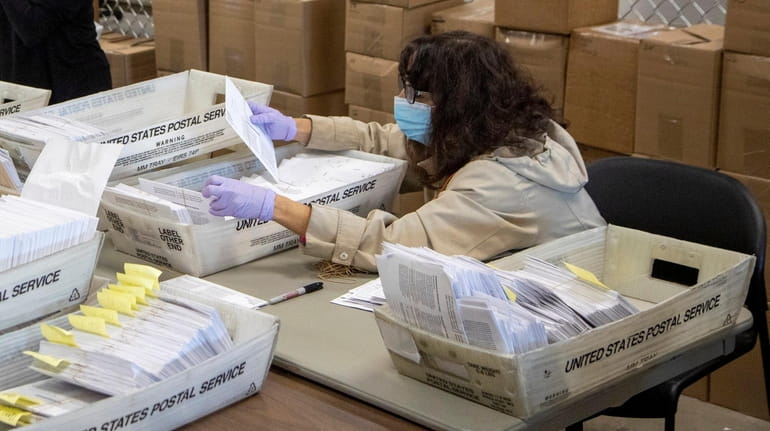On Long Island, purple reigns when it comes to presidential elections

Ballots are sorted at the Nassau County Board of Elections on Nov. 6 in Mineola. Credit: Howard Schnapp
Purple reigns, purple reigns.
That's — with apologies to Prince — how Long Island voters continued to behave, according to an analysis of 2020 election results for Nassau and Suffolk counties.
Purple, as in not red.
Purple, as in not blue.
Which may be why, in the days after Election night — but before the region's mother lode of absentee ballots could be counted — Nassau and Suffolk appeared to have soundly supported the reelection of Republican President Donald Trump.
But no, that was, as some local elected officials had warned, a red mirage.
It would take weeks for a clearer, more accurate picture to emerge.
Nassau, as it did in 2016, supported Trump's Democratic opponent.
Suffolk, as it did in 2016, supported Trump — but by a margin of fewer than 250 votes.
Turnout was far heavier this time around.
Still, a percentage comparison between 2020 and 2016 shows Trump lost favor with Long Island voters, pulling in 47% compared with the 49.1% he got in 2016.
And that 47%, by the way, was a tad less than the 47.51% that Hillary Clinton, Trump's Democratic opponent in 2016, received.
Taken together, the votes from Nassau and Suffolk then gave Democrat Joe Biden the win on Long Island as a whole — the opposite of what had appeared to be in the days after the vote, with Democrats harvesting more votes from moderate Long Island Republicans, independent voters and others compared with 2016.
In short, Long Island did what purple areas tend to do — swing.
In 2016, moderates went against the Democrat, Clinton; in 2020, they went against the Republican, Trump.
"It's an interesting comparison of strong personalities," said Lawrence C. Levy, executive dean at Hofstra University's National Center for Suburban Studies, when asked whether either year could be considered an anomaly for Long Island.
"In 2016, moderates on Long Island and elsewhere were turned off by Hillary Clinton; in 2020, it was Donald Trump," Levy said.
"I don't think it was one anomaly," he said. "I think it was two."
Dig deeper into Long Island's election map, and the overall purple coalesces into very different communities of red, and of blue.
That too follows the pattern for suburban areas, Levy said, with communities closer to city centers tending to vote more with Democrats; and those farther away, more with Republicans.
In Nassau's congressional races, Democrat Kathleen Rice was the first to declare victory. She didn't have to wait for absentees to determine that the heavily Democratic 4th District had voted to return her to Congress.
And in races for state senator, every Democrat in a competitive contest in Nassau won. GOP turnout in those races was strong, but not strong enough to overcome increased turnout of residents voting for Democrats.
In other races, things were trickier — because some districts, including those represented by U.S. Rep. Thomas Suozzi (D-Glen Cove) and retiring Rep. Peter King (R-Seaford), crossed county lines.
Suozzi, whose district spans parts of Suffolk, Nassau and Queens, won, although by slimmer margins in some Suffolk areas that backed Trump.
The King seat went to Republican Andrew Garbarino. The result was due, in part, to an infusion of votes from Nassau, which allowed Garbarino to overwhelm the showing of support for Democrat Jackie Gordon in some Suffolk portions of the district.
All of which reflects another reality about how Long Island votes, down at the community level, according to Levy.
"We can look at a map and we can see which communities tend to vote for Democrats and which tend to vote for Republicans," Levy said. "It's interesting because we can see areas where Long Island is segregated politically, just as it is segregated racially."
Next year, there will be races for county executive in Nassau and for county legislature in Nassau and Suffolk.
Then, the analysis will be less about red, blue or purple. It'll be more about whether candidates are successful in wooing Long Island's increasing number of voters with no party affiliation — and how successful they are in getting Long Islanders to the polls in the first place.

